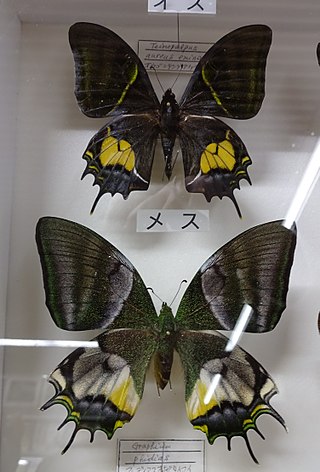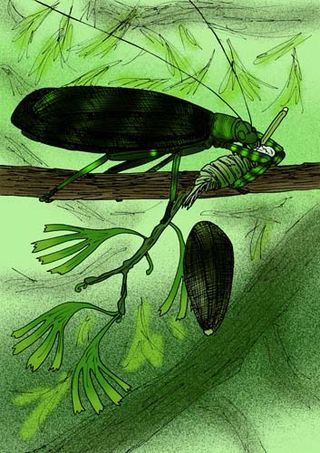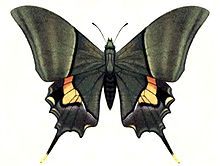
Lorisidae is a family of strepsirrhine primates. The lorisids are all slim arboreal animals and comprise the lorises, pottos and angwantibos. Lorisids live in tropical, central Africa as well as in south and southeast Asia.

Swallowtail butterflies are large, colorful butterflies in the family Papilionidae, and include over 550 species. Though the majority are tropical, members of the family inhabit every continent except Antarctica. The family includes the largest butterflies in the world, the birdwing butterflies of the genus Ornithoptera.

The Wuyi Mountains or Wuyishan are a mountain range located in the prefecture of Nanping, in northern Fujian province near the border with Jiangxi province, China. The highest peak in the area is Mount Huanggang at 2,158 metres (7,080 ft) on the border of Fujian and Jiangxi, making it the highest point of both provinces; the lowest altitudes are around 200 metres (660 ft). Many oolong and black teas are produced in the Wuyi Mountains, including Da Hong Pao and lapsang souchong, and are sold as Wuyi tea. The mountain range is known worldwide for its status as a refugium for several rare and endemic plant species, its dramatic river valleys, and the abundance of important temples and archeological sites in the region, and is a UNESCO World Heritage Site.

Papilioninae is a subfamily of the butterfly family Papilionidae. Papilioninae are swallowtail butterflies and are found worldwide, but most species are distributed in the tropics and warmer regions. This subfamily was classified in 1895 by Rothschild and Jordan.

Leptocircini is a tribe of swallowtail butterflies that includes the genera Eurytides, Graphium (swordtails), and Lamproptera (dragontails).

Paradoxurus is a genus of three palm civets within the viverrid family that was denominated and first described by Frédéric Cuvier in 1822. The Paradoxurus species have a broad head, a narrow muzzle with a large rhinarium that is deeply sulcate in the middle. Their large ears are rounded at the tip. The tail is nearly as long as the head and body.

Eacles imperialis, the imperial moth, is a member of the family Saturniidae and subfamily Ceratocampinae. It is found mainly in the East of South America and North America, from the center of Argentina to south Canada. The species was first described by Dru Drury in 1773.
Kaiser-i-Hind was a civilian award of the British Raj in India.

Teinopalpus imperialis, the Kaisar-i-Hind, is a rare species of swallowtail butterfly found from Nepal and north east India to north Vietnam. The common name literally means "emperor of India". The Kaisar-i-Hind is much sought after by butterfly collectors for its beauty and rarity. The green iridescence of the wings has been found to be due to three-dimensional photonic structure of the scales and is the subject of much research.

Papilio chikae, the Luzon peacock swallowtail, is a species of butterfly in the family Papilionidae. It is endemic to the Philippines. It has two subspecies, with P. c. chikae from Luzon and P. c. hermeli(Nuyda, 1992) from Mindoro. The latter was originally described as a separate species, but it resembles the nominate subspecies and there are no significant differences in their genitalia, leading recent authorities to treat them as subspecies of a single species.

Teinopalpus aureus, the golden Kaiser-i-Hind, is a species of butterfly in the family Papilionidae. It is found in China and possibly Vietnam. Considered an endangered species threatened by the wildlife trade, it is protected by Chinese law. Species distribution models show that montane forests in mid to high elevations within Southern China, Laos, and Vietnam are suitable habitats of T. aureus. However, they have poorly connected habitat networks and many of these areas are facing deforestation and severe climate change effects.

Titanoptera is an extinct order of neopteran insects from late Carboniferous to Triassic periods. Titanopterans were very large in comparison with modern insects, some having wingspans of up to 36 centimetres (14 in) or even 40 centimetres (16 in).

Staphylococcus is a genus of Gram-positive bacteria in the family Staphylococcaceae from the order Bacillales. Under the microscope, they appear spherical (cocci), and form in grape-like clusters. Staphylococcus species are facultative anaerobic organisms.

Clavatula is a genus of sea snails, marine gastropod mollusks in the family Clavatulidae.

Doi Pha Hom Pok National Park, formerly known as Mae Fang National Park and Doi Fa Hom Pok National Park, is the northernmost national park in Thailand. It straddles Fang, Mae Ai, and Chai Prakan Districts of Chiang Mai Province. The park covers 327,500 rai ~ 524 square kilometres (202 sq mi) of the mountain area of the Daen Lao Range, at the border with Myanmar. The tallest peak is Doi Pha Hom Pok at 2,285 metres (7,497 ft), the second highest in Thailand. The park was established on September 4, 2000.

Lycorma is a genus of planthoppers native to Asia. The first species within the genus was described by Frederick William Hope in 1843 and the genus was formally established by Carl Stål in 1863.

Lycorma imperialis is a planthopper indigenous to parts of China and Indo-Malaysia. L. imperialis was originally discovered in 1846 by Adam White and has one recognized non-nominate subspecies, L. i. punicea. L. imperialis has undergone a number of reclassifications since its discovery and is one of four species in the genus Lycorma. L. imperialis follows a hemimetabolous life cycle and will undergo a series of nymphal stages (instars) before maturing to an adult.
















